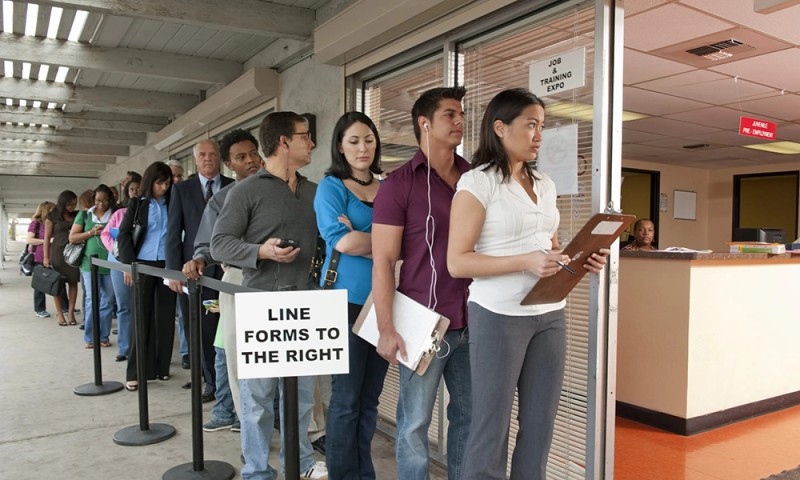
瑞银全球研究部(UBS Global Research)近期一份分析显示,2025年年中美国经济出现明显放缓,国内需求增长疲软、就业增长乏力,而新关税举措或将对通胀和整体经济动能造成影响。
这家瑞士银行发布的《美国经济周报》指出,2025年上半年实际国内生产总值年化增长率仅为1.2%,较2023年及2024年初的强劲增速大幅下滑。经济学家乔纳森·平格尔(Jonathan Pingle)领导的团队补充称,季度环比增长数据显示经济增长放缓,尤其是国内需求,其增速已从去年的3%以上降至近几个季度的约1%。
劳动力需求也呈现类似趋势。非农就业人数月度增长大幅放缓,7月仅新增7.3万个岗位——远低于预期,且此前数月的数据也遭大幅下调。过去三个月平均新增就业岗位仅为每月3.5万个,这一增速被美联储副主席米歇尔·鲍曼(Michelle Bowman)和理事克里斯托弗·沃勒(Chris Waller)形容为“失速速度”。[鲍曼和沃勒都是外界认为可能接替美联储主席杰罗姆·鲍威尔(Jerome Powell)的热门人选,而鲍威尔已遭到特朗普政府多次批评。]失业率小幅升至4.25%,为2021年以来的最高水平,而衡量劳动力利用不足的最广泛指标U-6失业率也呈上升趋势,较疫情前水平高出逾1个百分点。
关键的是,平格尔的团队发现,劳动力增长疲软背后的原因是劳动参与率下降,而非突发的移民或人口冲击。“劳动力参与率的下降掩盖了实际劳动力市场松弛的程度,”报告指出,并指出包括非裔美国人和青少年在内的多个群体正面临失业率上升和劳动参与率下降。
家庭调查显示的人口增长与前几年水平基本持平——这与“移民收紧显著抑制劳动力市场”的说法相悖。瑞银指出,这与杰罗姆·鲍威尔的表述矛盾:“尽管鲍威尔主席在联邦公开市场委员会(FOMC)新闻发布会上称,移民放缓正抑制人口增长,进而影响劳动力增长,但实际数据并非如此。家庭调查和机构调查更倾向于显示劳动力市场正趋于疲软,且家庭调查本身估计人口增长态势并未放缓。”
7月平均每周工作时长仍持续低迷,为34.25小时——不仅低于2019年水平,远非劳动力短缺导致市场紧张时常见的“工作时长延长”状态。行业细分数据显示,就业岗位减少并未集中于移民劳动力占比较高的行业,这进一步印证了当前劳动力市场疲软源于需求走弱,而非供给受限的观点。
关税即将上调,恐进一步拖累经济
经过一系列谈判和行政措施后,关税政策正朝着更加严格的方向发展。新出台的一揽子对等关税措施,包括对加拿大进口商品[符合《美墨加三国协议》(USMCA)的商品除外]征收35%的关税,以及对近70个国家实施全面加税。预计从8月初开始,美国加权平均关税税率(WATR)将从约16%升至约19%。瑞银估计,这将在未来一年内拖累经济增长率0.1至0.2个百分点。
尽管部分行业仍享有关税豁免,但欧盟如今大多数对美出口商品将面临15%的关税(虽低于最初提议的水平,但仍属大幅上调),瑞银预计此举将直接推高汽车、半导体、药品等领域的价格。美国总统提出的对药品加征200%关税的提议仍在讨论中,若付诸实施,将产生重大影响。
降息在即
随着越来越多证据表明经济增长和劳动力市场持续走软,叠加关税政策可能将核心通胀率从当前的2.8%进一步推高至年底的3.4%,美联储面临放松货币政策压力与日俱增。尽管主席杰罗姆·鲍威尔未排除9月降息的可能性,但他几乎未提供前瞻性指引,仅表示将“根据后续数据综合研判下一步行动”。瑞银维持其预期,即联邦公开市场委员会将在9月降息25个基点,并在2025年底前累计降息100个基点。
最终,瑞银发现,随着2025年推进,美国经济已明显进入放缓阶段,内需动能减弱,就业增长放缓,叠加关税上调的潜在压力可能进一步拖累经济前景。瑞银研究人员认为,数据表明经济放缓由需求驱动而非供应短缺,美联储可能很快会采取行动以实现经济“软着陆”。(*)
为撰写本报道,《财富》杂志使用生成式人工智能协助完成初稿。在发布前,编辑已核实信息准确性。
译者:中慧言-王芳
瑞银全球研究部(UBS Global Research)近期一份分析显示,2025年年中美国经济出现明显放缓,国内需求增长疲软、就业增长乏力,而新关税举措或将对通胀和整体经济动能造成影响。
这家瑞士银行发布的《美国经济周报》指出,2025年上半年实际国内生产总值年化增长率仅为1.2%,较2023年及2024年初的强劲增速大幅下滑。经济学家乔纳森·平格尔(Jonathan Pingle)领导的团队补充称,季度环比增长数据显示经济增长放缓,尤其是国内需求,其增速已从去年的3%以上降至近几个季度的约1%。
劳动力需求也呈现类似趋势。非农就业人数月度增长大幅放缓,7月仅新增7.3万个岗位——远低于预期,且此前数月的数据也遭大幅下调。过去三个月平均新增就业岗位仅为每月3.5万个,这一增速被美联储副主席米歇尔·鲍曼(Michelle Bowman)和理事克里斯托弗·沃勒(Chris Waller)形容为“失速速度”。[鲍曼和沃勒都是外界认为可能接替美联储主席杰罗姆·鲍威尔(Jerome Powell)的热门人选,而鲍威尔已遭到特朗普政府多次批评。]失业率小幅升至4.25%,为2021年以来的最高水平,而衡量劳动力利用不足的最广泛指标U-6失业率也呈上升趋势,较疫情前水平高出逾1个百分点。
关键的是,平格尔的团队发现,劳动力增长疲软背后的原因是劳动参与率下降,而非突发的移民或人口冲击。“劳动力参与率的下降掩盖了实际劳动力市场松弛的程度,”报告指出,并指出包括非裔美国人和青少年在内的多个群体正面临失业率上升和劳动参与率下降。
家庭调查显示的人口增长与前几年水平基本持平——这与“移民收紧显著抑制劳动力市场”的说法相悖。瑞银指出,这与杰罗姆·鲍威尔的表述矛盾:“尽管鲍威尔主席在联邦公开市场委员会(FOMC)新闻发布会上称,移民放缓正抑制人口增长,进而影响劳动力增长,但实际数据并非如此。家庭调查和机构调查更倾向于显示劳动力市场正趋于疲软,且家庭调查本身估计人口增长态势并未放缓。”
7月平均每周工作时长仍持续低迷,为34.25小时——不仅低于2019年水平,远非劳动力短缺导致市场紧张时常见的“工作时长延长”状态。行业细分数据显示,就业岗位减少并未集中于移民劳动力占比较高的行业,这进一步印证了当前劳动力市场疲软源于需求走弱,而非供给受限的观点。
关税即将上调,恐进一步拖累经济
经过一系列谈判和行政措施后,关税政策正朝着更加严格的方向发展。新出台的一揽子对等关税措施,包括对加拿大进口商品[符合《美墨加三国协议》(USMCA)的商品除外]征收35%的关税,以及对近70个国家实施全面加税。预计从8月初开始,美国加权平均关税税率(WATR)将从约16%升至约19%。瑞银估计,这将在未来一年内拖累经济增长率0.1至0.2个百分点。
尽管部分行业仍享有关税豁免,但欧盟如今大多数对美出口商品将面临15%的关税(虽低于最初提议的水平,但仍属大幅上调),瑞银预计此举将直接推高汽车、半导体、药品等领域的价格。美国总统提出的对药品加征200%关税的提议仍在讨论中,若付诸实施,将产生重大影响。
降息在即
随着越来越多证据表明经济增长和劳动力市场持续走软,叠加关税政策可能将核心通胀率从当前的2.8%进一步推高至年底的3.4%,美联储面临放松货币政策压力与日俱增。尽管主席杰罗姆·鲍威尔未排除9月降息的可能性,但他几乎未提供前瞻性指引,仅表示将“根据后续数据综合研判下一步行动”。瑞银维持其预期,即联邦公开市场委员会将在9月降息25个基点,并在2025年底前累计降息100个基点。
最终,瑞银发现,随着2025年推进,美国经济已明显进入放缓阶段,内需动能减弱,就业增长放缓,叠加关税上调的潜在压力可能进一步拖累经济前景。瑞银研究人员认为,数据表明经济放缓由需求驱动而非供应短缺,美联储可能很快会采取行动以实现经济“软着陆”。(*)
为撰写本报道,《财富》杂志使用生成式人工智能协助完成初稿。在发布前,编辑已核实信息准确性。
译者:中慧言-王芳
The U.S. economy is experiencing a noticeable slowdown in mid-2025, with sluggish domestic demand growth, muted job gains, and new tariff actions poised to impact both inflation and overall economic momentum, according to a recent analysis from UBS Global Research.
The US Economics Weekly note from the Swiss bank noted real GDP grew at an annualized rate of just 1.2% in the first half of 2025, a significant step down from the more robust pace observed in 2023 and early 2024. Quarter-over-quarter growth figures point to a sequential weakening, the team led by economist Jonathan Pingle added, particularly in domestic demand, which has dropped from above 3% last year to around 1% in recent quarters.
Labor demand is responding in kind. Monthly nonfarm payroll growth has slowed sharply, with July seeing an increase of only 73,000 jobs—well below expectations and accompanied by sizeable downward revisions for previous months. The three-month average for job gains is now just 35,000 per month, a rate described as “stall speed” by Federal Reserve Vice Chair Michelle Bowman and Governor Chris Waller. (Both Bowman and Waller are prominent names floated to replace Fed chair Jerome Powell, a figure the Trump White House has extensively criticized.) The unemployment rate ticked up to 4.25%, the highest level since 2021, and the broadest measure of labor underutilization, known as U-6, is also trending higher—more than a percentage point above pre-pandemic levels.
Crucially, Pingle’s team found shrinking labor force participation rather than a sudden immigration or population shock is behind the weaker labor force growth. “The drop in the labor force participation rate has masked how much slackening is actually taking place,” the report contends, noting that multiple demographic groups, including Black Americans and teenagers, are showing higher unemployment and falling participation.
Population growth as recorded by the household survey is holding steady near previous years’ levels—contradicting assertions that tighter immigration is meaningfully constricting the labor market. UBS notes this contradicts statements from Jerome Powell: “Despite Chair Powell’s pronouncement at the post FOMC press conference that the immigration slowdown was slowing population growth and thus labor force growth, that is not what is happening in the actual data. The Household Survey and Establishment Survey look more like the labor market is slackening, and the household survey itself estimates that population growth is not slowing.”
The average workweek remains subdued, sitting at 34.25 hours in July—below 2019 levels and far from the “stretching” typical when labor markets are tight due to worker shortages. Industry-specific data show that job losses are not concentrated in sectors with large immigrant workforces, further supporting the view that slack comes from weakened demand, not a supply constraint.
Tariffs set to climb, threatening further drag
Tariff policy, after a series of negotiations and executive actions, is on track to become even more restrictive. The new suite of reciprocal tariffs, including a 35% rate on Canadian imports (excluding USMCA-compliant goods) and across-the-board hikes affecting nearly 70 countries, is expected to raise the U.S. weighted average tariff rate (WATR) from about 16% to approximately 19% starting in early August. UBS estimates this will subtract 0.1 to 0.2 percentage points from growth over the next year.
Sectoral carve-outs persist, but with the EU now facing a 15% tariff on most exports to the U.S.—lower than originally proposed, but still a significant rise—UBS expects direct pressure on prices for automobiles, semiconductors, pharmaceuticals, and more. Presidential proposals to slap a 200% tariff on pharmaceuticals remain under discussion, but would have massive implications if implemented.
Rate cuts on the horizon
With evidence mounting that both growth and labor markets are softening and that tariffs may further boost core inflation from 2.8% currently to as high as 3.4% by year-end, pressure is building for the Federal Reserve to ease monetary policy. While Chair Jerome Powell kept a possible September rate cut on the table, he offered little forward guidance, stating that the totality of incoming data will dictate the next move. UBS maintained its expectation that the Federal Open Market Committee will cut rates by 25 basis points in September and by as much as 100 basis points before the end of 2025.
Ultimately, the bank found that the U.S. economy has entered a clear slowdown as 2025 unfolds, with fading domestic momentum, cooling job growth, and the shadow of higher tariffs likely to dampen the outlook further. UBS researchers argue that the data show a demand-driven deceleration, not a supply squeeze, and that the Fed will likely act soon to cushion the landing.
For this story, Fortune used generative AI to help with an initial draft. An editor verified the accuracy of the information before publishing.

